Bouldering in Fontainebleau: All You Need for a Great First Trip
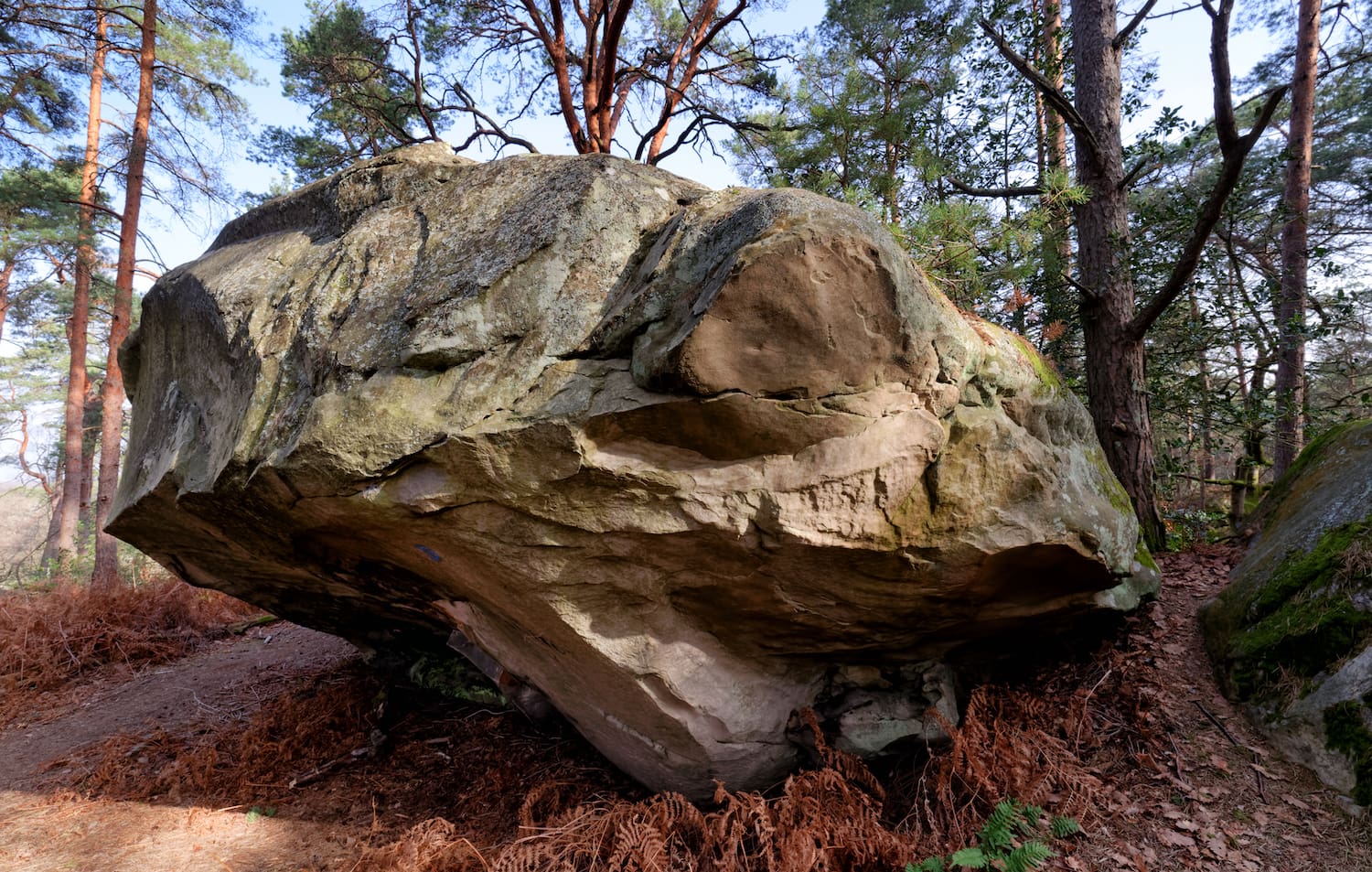
Published on: 01/14/2022
Fontainebleau is a climbing destination located roughly 40 miles south of France. Not only is the region a beautiful nature spot in its own right, but it’s also one of Europe‘s bouldering hotspots. Home to over 20,000 different bouldering routes, Fontainebleau attracts climbers from all over the world. Most of the site’s routes are located within the forest. However, there are some worthwhile bouldering routes in the forests and towns neighboring Fontainebleau, too.
The park’s size can make it tricky to navigate or get the most out of, though. With so many different routes and problems, where do you even begin? This is why we’ve compiled our guide to Fontainebleau bouldering and its various climbing areas. We go over the logistical side of a bouldering trip to Fontainebleau, as well as the holy grail routes. So, if you’re planning a visit to Fontainebleau any time soon, read on to find out more!
What Makes Fontainebleau so Special?

As mentioned above, Fontainebleau is fairly close to Paris. Combine this with the fact that the park is widely considered to be one of the best for bouldering in the world? It’s not hard to see why the area is such a popular destination among boulderers. Plus, the park offers access to boulder problems of all difficulty levels and styles to climbers.
Indeed, it’s likely this huge number of sandstone routes concentrated into a manageable area that makes Fontainebleau such a mecca for climbers. With technical slabs, huge traverses, modern-style bouldering, roofs, and more, the park has something to offer just about everyone. No matter what style of bouldering you like best, you should be able to have a great first time in the park.
Fontainebleau has long been a top bouldering destination. The first guidebook for the park came out in the 1940s! Many of bouldering’s best athletes have subsequently cut their teeth and made their names in the area. To this day, the incredibly wide variety of bouldering routes has climbers coming to the region in huge numbers.
Transport and Accommodation
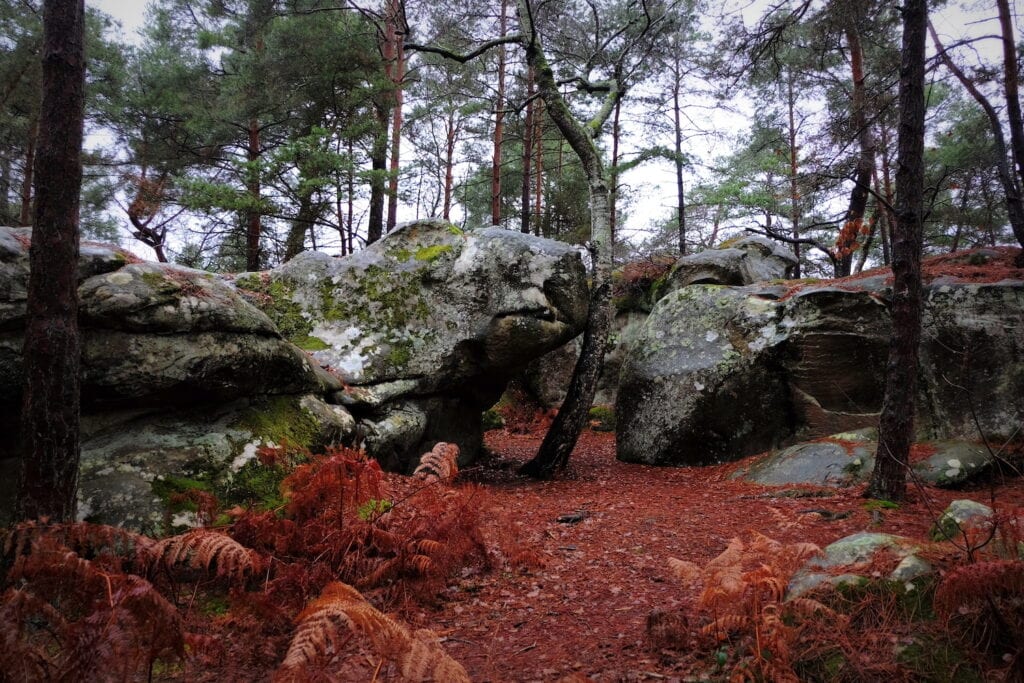
Fontainebleau is located around an hours’ drive away from Paris. This makes the spot very accessible and is a large factor in its popularity. While Fontainebleau’s tourist infrastructure is somewhat limited, the area is, fortunately, host to a decent variety of accommodation options. Within and around the forest, you can hotels, campgrounds, hostels, and self-serviced cabins. Campsite conditions do vary, so if you’re planning on camping, it would be wise to plan this out in advance.
As far as transport is concerned, if you don’t have a car, then you might like to get around by bike or bus. You can rent bikes in the surrounding villages, as well as from some accommodation providers. Bus services in the area are somewhat limited, so make sure to familiarise yourself with the timetable before you set out.
Getting to Fontainebleau
Getting to Fontainebleau via Paris is easy and fairly quick. Driving to the area from Paris only takes around an hour. Additionally, the region does have a train station, called Fontainebleau Avon. The train ride is fairly quick and is a good option if you’re not picking up a rental car in Paris.
A Guide to the Different Spots in Fontainebleau

Sandstone boulders make up all the bouldering in Fontainebleau, much of which involves sandy landings. There is actually a special rating system for Fontainebleau, though not many climbers use it extensively. In short, much of the bouldering in the park is on the trickier side. Holds on many classic problems are somewhat worn and slick, which can make it difficult to get a proper grip.
The Most Popular Areas in Fontainebleau
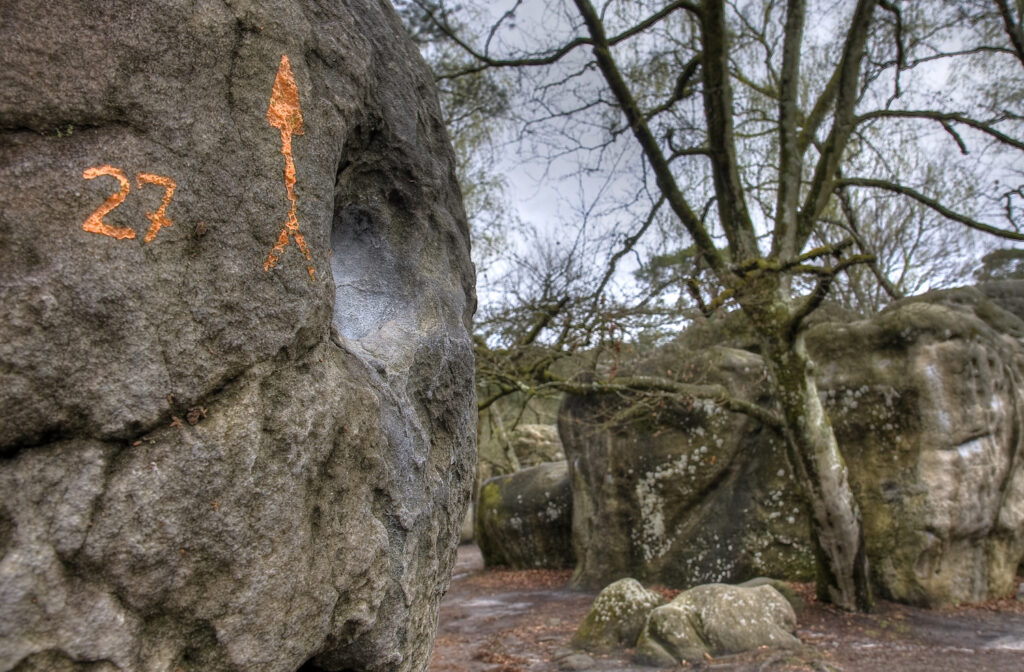
Bas Cuvier might be the most popular area in the whole park. Just about every climber who visits the area is going to check out Bas Cuvier, and many of them head here first. The spot is fairly close to the local village, making it a fairly natural place to visit for many. What’s more, it’s home to an incredible range of boulder problems and is fairly compact. Its popularity does mean it attracts crowds, so avoiding Bas Cuvier at the busiest times of the season is probably wise.
The Trois Pignons area hosts over 300 problems ranging from beginner to expert. With slab, vertical, steep wall, and overhang climbing, this is a very popular spot for boulderers from all kinds of disciplines. The area’s incredible beauty is just the icing on the cake.
Top Climbing Areas in Fontainebleau by Grade

For Beginners
Cul de Chien is an interesting, smaller area with mostly beginner routes. Many of the footholds in this area are fairly polished, though, most likely due to the sand ground. One strength of the area is that it dries up quite quickly after rain.
L’Elephant is a forgiving area with a huge range of problems to work on. Many of the boulders have great landings, too; visitors commonly remark that you won’t even need a crash pad when climbing here. Many of the boulders here are in the beginner grades, but you will also find some more advanced lines, too.

For Intermediate/Advanced Climbers
95.2 is a fairly mixed area, but many of its best-known boulders are towards the intermediate or advanced end of things. You’ll find that most of the projects here are on low blocs with great, soft landings. However, there are problems of a wide range of styles in 95.2. This is another area that dries out quickly after it’s rained, too.
The Roche aux Sabots site is a popular spot just a short walk away from one of the main carparks in the park. While most of the problems are intermediate or advanced, none of them are too far off the ground.
You’ll find the Isatis area deep in the forest, away from the carpark. Isatis is home to a nice selection of 7A-C problems, as well as some easier ones. This is one of the more visited areas in the park, so you may want to avoid it at peak times. Still, with almost 1,000 problems for you to try out, it’s absolutely not to be missed!
For all the routes, you can check out this very complete directory: https://bleau.info/
How to Get the Most out of your Trip

Plan Ahead
Traveling with a group of English speakers, or simply don’t have anyone in your group who speaks French? If so, we would definitely recommend that you plan your journey thoroughly before setting out. While the locals are super friendly, many of them only speak French. In addition, the area is not very touristic, despite its popularity. Supporting infrastructure for climbing and for travelers alike is somewhat limited.
Have a Car
For one thing, we strongly recommend that you have access to a car throughout your journey if at all possible. You might like to rent one in Paris or even make a road trip to Fontainebleau from wherever you’re traveling from. Fontainbleau is fairly large, adding up to around 900 square km. Being able to drive around the area will save you lots of time and help you make the most of your trip.
Also, it’s important to reiterate that not all of the bouldering projects in in the area are located within Fontainebleau Forest. Some of them are in nearby towns and forests, like Nemours and Milly la Forêt. If you’re planning on trying any of these routes, then having a car is virtually a godsend. NOTE: car break-ins are, unfortunately, fairly common at the park. Please make sure not to leave any valuables in your vehicle, even if parked at the car park.
Try the Circuits
One of the best things about Fontainebleau is its network of circuits. The circuits are part of different bouldering areas and generally contain somewhere between 20-60 individual problems. Arrows and numbers are painted onto the rock walls to show what part of the circuit you’re at and where to find the next route. These circuits can be a wonderful way to test your endurance, but be careful not to burn yourself out!
Take a Brush and your Chalk
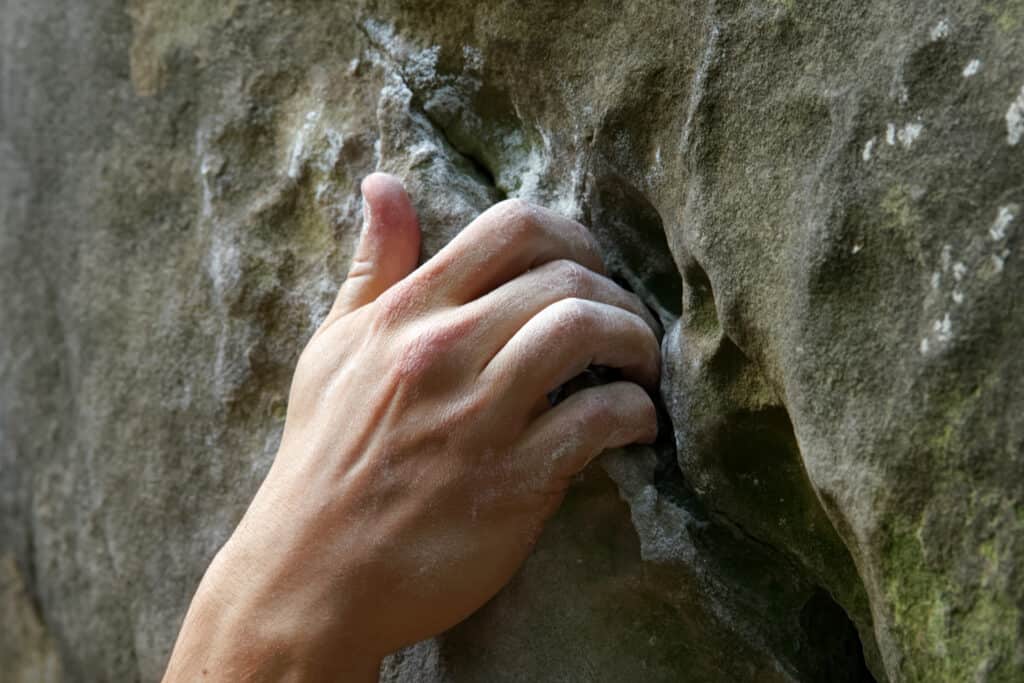
For some, this might sound like a no-brainer. However, as mentioned above, many of the classic projects in the park have holds that are quite worn down. Some of these are sheltered from the rain and can get sticky from use. So, one of our top tips is to make sure to take a brush and chalk with you. Brushing down the holds and using chalk will help you stick much better to the holds. If you don’t typically use a brush, you can purchase one from one of the climbing shops in the town of Fontainebleau.
Fontainebleau Stories and Legends
So many famous climbers have spent time in the mountains and forests of the Fontainebleau area to hone their bouldering skills. One notable example is Adam Ondra, who reportedly had some trouble adjusting to the ‘Font’ style of climbing. Ondra is said to have fallen off a V6 boulder in the area!
The history of the park goes back a long way. In fact, many would argue that the area is essentially the birthplace of modern bouldering. However, Fontainebleau has served several purposes. Before bouldering really rose to prominence in its own right, the area was a mountaineering training ground. Mountaineers would travel to the park to practice climbing on its many boulders, before heading to the Alps to put what they’d learned into practice.
Guidebook Suggestions

There is an incredible number of guidebooks for Fontainebleau. If you’re looking for a comprehensive introduction to the park, then your best bet is probably Fontainebleau Fun Bloc by David Atchison-Jones. The book covers over 7,000 boulders ranging from 1a to 8c. Many of the projects in this book fall within the most popular areas of the park. So, the guide makes for a great way to sample many of the area’s classic problems.
Another excellent guide to the park is Fontainebleau Climbs by Montchausse. This book is largely based on the various circuits in the area. Over 300 circuits and 3,000 problems are covered in the guidebook, which also comes with a topographic map.
If you’re looking to get off the beaten track, then consider Fontainebleau: Top Secret, by David Atchinson-Jones. This incredible guide describes over 9,000 of the lesser-known problems in the park, making it a great choice if you want to beat the crowds.
FAQs
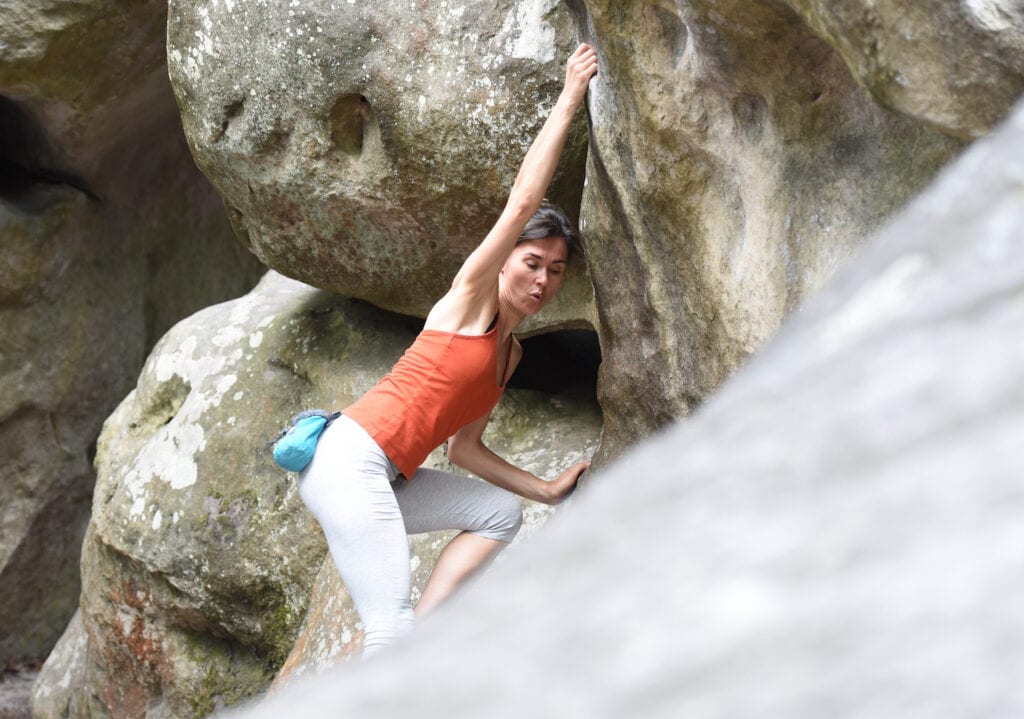
The Fontainebleau Forest is home to more than 20,000 bouldering routes! You could spend your whole time in the area and still struggle to send each and every route.
We would argue that Fontainebleau has projects at all difficulty levels. Anyone, from first-timers to the most advanced athletes, should be able to get some great climbs in at the park. However, on the whole, the park does skew towards more difficult boulders.
It is possible to rent crash pads in Fontainebleau. A number of local companies offer crash mat rental at varying prices. Some of the better-known companies include Sport Outdoor and S’cape. Do be mindful that, during busy periods, crash pads might get completely booked out. The busiest times for climbing the park tend to include school holidays and the summer. So, if you’re planning on visiting the park at this time, sort out crash pads early to avoid disappointment.
You can essentially climb Fontainebleau all year round. However, when considering crowds and the weather, we think the best time to visit the area would be sometime in spring or autumn. Summer temperatures in the area are relatively mild but do get high enough to be a nuisance if you’re rock climbing all day. The park does also see some snow in winter.
Looking for more climbing destinations? Check out all our guides.
